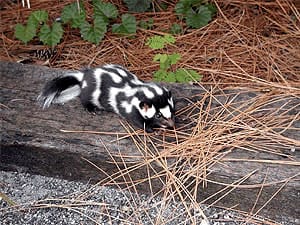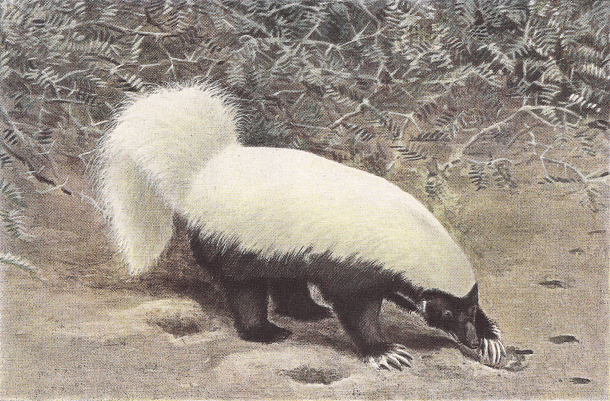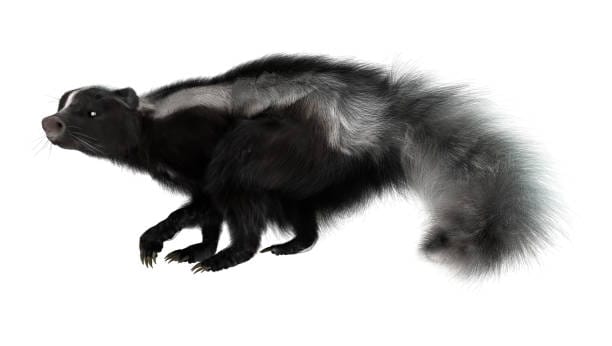North Carolina is rich in wildlife, and among its most fascinating small mammals are skunks. Often recognized for their powerful defense spray, skunks in North Carolina play a crucial role in controlling insects, rodents, and other pests. Understanding the types of skunks in North Carolina helps wildlife enthusiasts, gardeners, and homeowners coexist safely with these creatures. This article reviews four skunk species found or occasionally observed in the state, covering their appearance, behavior, habitats, diets, reproduction, and interactions with humans. By the end, you’ll be able to identify each species and appreciate their ecological importance while learning practical tips for safe encounters.
1. Striped Skunk (Mephitis mephitis)

Physical Characteristics & Identification Tips
The Striped Skunk is the most recognizable and commonly seen skunk in North Carolina. Adults weigh between 6 and 10 pounds and measure about 20–30 inches from nose to tail tip. Their glossy black fur features two broad white stripes running from head to tail. Their ears are small and rounded, and their pointed snout adds to a curious appearance. When trying to identify a striped skunk, watch for its signature stripes and rounded body. If threatened, the skunk may raise its tail and stamp its feet, signaling potential danger.
Behavior
Striped skunks are mostly nocturnal and solitary. They forage at night, moving slowly while sniffing for insects, small rodents, eggs, and fruits. Their primary defense is the potent spray, which can reach up to 10 feet. Despite their reputation, they are not aggressive and usually avoid confrontation. In suburban areas, striped skunks have adapted to scavenging from trash bins, gardens, and compost piles, showing remarkable flexibility in their habits.
Habitat and Range
Found throughout North Carolina, striped skunks inhabit forests, open fields, and suburban environments. They prefer areas with cover such as brush piles, hollow logs, or under sheds. They are not true hibernators; in cold weather, they enter a state of torpor but may emerge on mild nights to forage. Striped skunks often reuse dens, including those abandoned by other animals.
Diet
Omnivorous by nature, striped skunks feed on insects, grubs, small mammals, eggs, fruits, and berries. Their diet changes with the seasons, with insects being more prevalent in summer and plant material and small rodents more important in colder months. This adaptability helps them thrive in diverse habitats.
Reproduction and Life Cycle
Breeding occurs in late winter, and females give birth to 4–6 kits in spring. Kits are born blind and helpless, opening their eyes around three weeks old and beginning to explore at six weeks. By late summer, young skunks disperse to establish their own territories. Lifespan in the wild is generally 2–3 years, though some may live up to five.
Fun Facts / Noteworthy Traits
- A striped skunk can spray up to six times before depleting its scent glands.
- They groom regularly and are surprisingly clean.
- Predators often avoid skunks due to their potent defensive spray.
Human Interaction
Encounters with humans are usually accidental. Preventing issues involves securing trash bins, removing pet food, and blocking access under decks. If a pet is sprayed, a mixture of hydrogen peroxide, baking soda, and dish soap works effectively to remove odor.
2. Eastern Spotted Skunk (Spilogale putorius)

Physical Characteristics & Identification Tips
The Eastern Spotted Skunk is smaller and more elusive than the striped skunk. Adults weigh 1–3 pounds and measure 16–24 inches in length. Their black fur with broken white stripes and spots sets them apart. Their slender build and bushy tail give them an acrobatic appearance. When threatened, they perform a distinctive handstand, raising their tail as a warning to predators — a dramatic display that makes them memorable.
Behavior
Eastern Spotted Skunks are nocturnal, solitary, and agile. They can climb small trees and squeeze through tight spaces. Their foraging is quiet and careful, feeding on insects, small mammals, fruits, and eggs. Due to their secretive habits and preference for dense cover, they are less often seen than striped skunks, even in overlapping territories.
Habitat and Range
These skunks are scattered across North Carolina, favoring overgrown fields, brushy edges, and rural woodlands. They often occupy abandoned burrows or hollow logs. Maintaining brushy areas and limiting pesticide use supports their populations, as insects form the bulk of their diet.
Diet
Omnivorous but insect-focused, Eastern Spotted Skunks eat beetles, grasshoppers, moths, small rodents, eggs, and seasonal fruits. They are valuable for natural pest control, often going unnoticed due to their secretive nature.
Reproduction and Life Cycle
Breeding occurs in late winter, but implantation is delayed until spring. Litters typically include 4–5 kits. They remain with the mother until early summer. Lifespan is around three years, and survival depends on avoiding predators and finding adequate food and shelter.
Fun Facts / Noteworthy Traits
- The handstand warning display is unique among skunks.
- They are capable climbers, unlike most other skunk species.
- Despite their smaller size, their spray is potent and effective.
Human Interaction
These skunks rarely enter urban areas. Observing them from a distance is safest. Conservation efforts include preserving brushy edges and reducing pesticide use.
3. Hog-Nosed Skunk (Conepatus leuconotus)

Physical Characteristics & Identification Tips
The Hog-Nosed Skunk is larger, weighing up to 15 pounds, with a distinctive pale dorsal stripe and a pig-like snout for digging. Though native to the southwestern U.S., rare individuals may wander into North Carolina. Their long snout and broad stripe distinguish them from other skunks in the state.
Behavior
Nocturnal and solitary, Hog-Nosed Skunks are skilled diggers, rooting for insects, grubs, and plant roots. Foot-stomping and vocal warnings precede spraying when threatened.
Habitat and Range
Preferred habitats include open fields, scrublands, and forest edges. In North Carolina, sightings are extremely rare and exciting for wildlife enthusiasts.
Diet
They primarily eat insects and invertebrates, along with roots and fruits. Their digging benefits soil health and pest control.
Reproduction and Life Cycle
Breeding occurs in early spring, with litters of 2–6 young. Kits remain in the den until they can accompany the mother on nightly foraging. Lifespan in the wild reaches up to four years.
Fun Facts / Noteworthy Traits
- The long snout is adapted for rooting out insects and tubers.
- They have a single broad stripe unlike other skunks.
- Rare visitors contribute to North Carolina’s wildlife diversity.
Human Interaction
Encounters are rare. Observing and reporting sightings helps wildlife agencies track potential expansion.
4. Hooded Skunk (Mephitis macroura) — Possible Visitor

Physical Characteristics & Identification Tips
The Hooded Skunk is occasionally recorded in North Carolina. It has a slender build, a long tail, and a pale hood-like marking over the head and shoulders. Size is similar to striped skunks, but their markings are less continuous.
Behavior
They are nocturnal, solitary, and cautious. When threatened, they raise their tail and may spray. They forage quietly for insects, small mammals, and plant material.
Habitat and Range
They favor forests and brushy areas. As occasional visitors, their presence in North Carolina is not consistent.
Diet
Omnivorous, eating insects, small mammals, fruits, and roots. Their diet helps control pests and supports ecosystem balance.
Reproduction and Life Cycle
Breeding occurs in early spring. Litter sizes are similar to other skunks, with kits dependent on their mother for several weeks.
Fun Facts / Noteworthy Traits
- Less commonly observed, making sightings exciting for wildlife enthusiasts.
- Markings are variable, sometimes resembling a hood.
- Like other skunks, their spray deters predators effectively.
Human Interaction
Rare encounters are generally harmless. Observing from a distance and respecting their habitat is safest.
Conclusion
The types of skunks in North Carolina — Striped Skunk, Eastern Spotted Skunk, Hog-Nosed Skunk, and the occasional Hooded Skunk — each contribute to the state’s ecosystems by controlling pests, improving soil, and supporting biodiversity. Understanding their behavior, habitats, and diets helps humans coexist safely while appreciating these fascinating nocturnal mammals. Observing them responsibly can be both educational and rewarding.
Frequently Asked Questions About Skunks in North Carolina
1. How many types of skunks are found in North Carolina?
North Carolina hosts four skunk species: Striped Skunk, Eastern Spotted Skunk, Hog-Nosed Skunk, and the occasional Hooded Skunk.
2. Which skunk is most common in North Carolina?
The Striped Skunk (Mephitis mephitis) is the most frequently observed skunk in the state.
3. Where do skunks live in North Carolina?
They inhabit forests, open fields, farmlands, and suburban areas, often near water and cover.
4. Are skunks dangerous to humans or pets?
Skunks are generally not aggressive. Their main defense is spraying, and they can carry rabies.
5. What do skunks eat?
Skunks are omnivores, feeding on insects, small mammals, eggs, fruits, and berries.
6. When are skunks active?
They are nocturnal, mainly active at night with peak activity around dusk and dawn.
7. Do skunks hibernate in North Carolina?
They enter torpor in winter but do not fully hibernate.
8. How can I tell a striped skunk from an Eastern spotted skunk?
Striped skunks have two continuous stripes, while Eastern spotted skunks have broken stripes and spots.
9. Are Eastern Spotted Skunks endangered?
They are a species of concern due to habitat loss and pesticide use.
10. How far can a skunk spray?
Skunks can spray accurately up to 10 feet.
11. What should I do if a skunk sprays near my home?
Ventilate the area and clean with a mixture of hydrogen peroxide, baking soda, and dish soap.
12. Can skunks climb trees?
Eastern Spotted Skunks can climb small trees, whereas striped skunks mostly stay on the ground.
13. How long do skunks live in the wild?
Typically 2–3 years; some may live up to 5 years.
14. What attracts skunks to yards?
Food sources, trash bins, pet food, grubs, and shelter under decks or sheds.
15. How can I keep skunks away humanely?
Seal access under decks, remove outdoor food, and use motion-activated deterrents.
16. When do skunks have babies?
Breeding occurs in late winter, with kits born in spring.
17. Are skunks legal to keep as pets?
No. Wild skunks are protected and keeping them as pets is illegal in North Carolina.
18. Why do skunks raise their tails before spraying?
Tail raising signals danger and warns predators before spraying.
19. How do skunk tracks look?
Five toes with visible claw marks; smaller than raccoon tracks.
20. What predators hunt skunks?
Owls, foxes, bobcats, and coyotes, though many avoid skunks due to their spray.
21. Do skunks help the environment?
Yes, they control insects and rodents and improve soil through digging.
22. What should I do if I find a baby skunk alone?
Observe from a distance; contact a licensed wildlife rehabilitator if abandoned.
23. Are skunks common in suburban areas?
Striped skunks are common; Eastern spotted skunks prefer rural, brushy areas.
24. How do skunks communicate?
They hiss, growl, stomp their feet, perform handstands (spotted skunks), and scent-mark territory.
25. Can skunks dig under fences?
Yes, burying fences 12 inches deep and angling outward can help prevent entry.
26. What is the rarest skunk in North Carolina?
Eastern Spotted Skunk is rare and elusive.
27. Have Hog-Nosed Skunks been seen in North Carolina?
They are rare visitors with occasional sightings.
28. Do skunks carry diseases?
Yes, including rabies. Avoid direct contact.
29. What should I do if my pet is sprayed?
Wash them with hydrogen peroxide, baking soda, and dish soap mixture.
30. Do skunks make sounds?
Yes, they hiss, growl, or chirp when threatened or communicating with kits.
31. What time of year are skunks most visible?
Early spring and late summer, during breeding and when young explore.
32. How can I tell if a skunk is living under my shed?
Look for small holes, musky odors, soil disturbance, and nighttime activity.
33. Can skunks swim?
Yes, but they prefer dry ground.
34. Are skunks protected in North Carolina?
Yes, handling and removal require licensed professionals.
35. Why are skunks important to ecosystems?
They control pests, disperse seeds, and enrich soil.
36. How can I safely observe skunks?
Use a flashlight at night from a distance and avoid startling them.
37. What is the difference between striped and hog-nosed skunks?
Hog-Nosed Skunks have a pig-like snout and pale dorsal stripe; striped skunks have bold black-and-white stripes.
38. Can skunks spray more than once?
Yes, striped skunks can spray multiple times before recharging scent glands.
39. Do skunks dig for food?
Yes, they use their claws to uncover insects, grubs, and roots.
40. Can skunks climb fences?
Some species, like Eastern Spotted Skunks, can climb short fences; striped skunks generally cannot.
41. Are skunks active during the day?
Rarely. They are mainly nocturnal and may be active in daylight if disturbed.
42. How do I deter skunks from my garden?
Remove food, secure compost, and use fencing or motion-activated sprinklers.
43. Can skunks carry fleas or ticks?
Yes, which can transfer to pets. Limit direct contact.
44. What should I do if I see a skunk in my yard?
Keep distance, secure pets, and avoid sudden movements.
45. How do skunks mark territory?
Using scent glands near the tail, they mark territory and communicate with other skunks.
Read more: 3 Types of Skunks in Ohio (Pictures And Identification)
